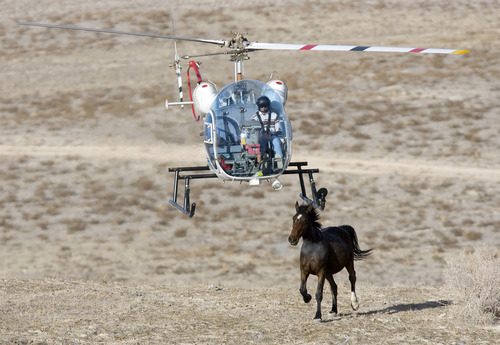This is an archived article that was published on sltrib.com in 2013, and information in the article may be outdated. It is provided only for personal research purposes and may not be reprinted.
The Bureau of Land Management on Tuesday commenced rounding up wild horses from Utah's Swasey herd, which federal officials say has five times as many animals as the range can support.
Under the operation 50 miles west of Delta, expected to take seven to 10 days, helicopter wranglers will gather 262 horses. One hundred will be released back into the Swasey Herd Management Area — one of Utah's 19 HMAs on federal land. Many of the horses released will be mares treated with the contraceptive Porcine Zona Pellucida (PZP-22).
The public is invited to observe "the gather." Information on how to do that is available online at http://on.doi.gov/Veoq7y.
The gather is part of BLM's approach — criticized by some wild horse advocacy groups — to managing federally protected horses and burros that roam public lands of the West. The animals are not native to the range but are the feral descendants of horses turned loose by the region's early European explorers. While 36,000 horses remain free, about 50,000 are in captivity on private ranches, warehoused at enormous public expense.
Wild horse advocates claim the roundups, often conducted by helicopter, traumatize the animals, and ultimately divert millions in taxpayer dollars to private contractors, such as Cattoor Livestock Roundup Co., the Nephi-based firm handling the Swasey roundup.
BLM officials say helicopters are a safe, efficient and humane way to pull horses off the range, although they use bait trapping to capture small groups of horses. But in the wake of recent video documentation of possible mistreatment at a Nevada roundup, BLM strengthened its roundup guidelines to ensure public access, transparency and humane treatment.
But horse advocates would rather the capture operations not take place, arguing the government's ability to pasture them is reaching an end and horses can be kept on the range if grazing pressure is reduced.
Based on aerial surveys, BLM officials say horses number 350 on the 120,000-acre Swasey area that covers the House Range and surrounding desert. BLM says this area can handle just 60 to 100 horses. The agency last rounded up Swasey horses nearly six years ago when 155 were removed. This week's roundup will leave fewer than 200 horses, and the agency plans to return for another roundup in three years and then try to keep the herd at 150 through contraception, according to Gus Warr, who supervises Utah's wild horse program.
Advocates say the roundup would not be necessary if BLM reduced grazing in the area by 30 percent. The agency allows the equivalent of 662 cow-calf pairs or 3,212 sheep on the management area, a number that far exceeds the number of horses currently there, according to the Cloud Foundation, a wild horse advocacy group.
"Allocating them only 13 percent of the forage within their own HMA does not constitute a fair share, let alone a principal share," the foundation argued in its comments on a recent environmental analysis.
Official say that lack of water in the summer, not forage, is the limiting factor on horses.



